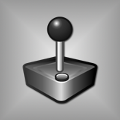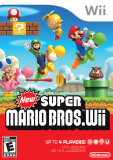Games
Displaying 12771-12780 of 15808 results.
Nintendo Entertainment System (NES)
Release Date: October 23, 1988 |
Genre: Adventure
Super Mario Bros. 3 is a two-dimensional platform game in which the player controls the on-screen protagonist (either Mario or Luigi) from a third-person perspective. The game shares similar gameplay mechanics with previous titles in the series—Super Mario Bros., Super Mario Bros.: The Lost Levels, and Super Mario Bros. 2—but introduces several new elements. In addition to the running and jumping moves found in past games, the player can fly and float with the aid of special items, slide down slopes, and execute new types of jumps.
Nintendo Game Boy Color
Release Date: April 30, 1999 |
Genre: Platform
Bowser has once again taken over the Mushroom Kingdom, and it's up to Mario to put an end to his sinister reign. Battle Bowser's vile henchmen through 32 different levels - all taken directly from the 1985 classic! Then move on to collect special Red Coins and Yoshi Eggs in the Challenge Mode. Or face off against a friend and race through 8 competition courses in the all-new VS Mode! This time there's a lot more to do than just save a Princess, so get ready for a brick-smashin', pipe-warpin', turtle-stompin' good time!
Nintendo Wii
Release Date: November 15, 2009 |
Genre: Platform
New Super Mario Bros. Wii, like all the previous releases in the Super Mario Bros. franchise, is a side-scrolling platforming game where players collect coins as they attempt to make their way through progressively more difficult game levels using their ability to time jumps over obstacles and avoid a slew of enemies. But although the game contain several well-deserved nods to previous games in the series in the form of iconic characters like Mario, Luigi and two Toads, as well as familiar enemies, sound effects and levels, it is not simply another trip down Mario Bros. memory lane. Taking advantage of the flexibility and power of the Wii and Wii Remote, New Super Mario Bros. Wii manages to preserve the retro experience that fans love about the series, while adding new game features. Notable additions among these include, expansive play levels and new power-ups and characters, but by far the most important, and in fact game-defining new feature is simultaneous multi-player.
Nintendo Entertainment System (NES)
Release Date: January 1, 1988 |
Genre: Action
Super Mario Bros. / Tetris / Nintendo World Cup is a Miscellaneous game, developed and published by Nintendo, which was released in Europe in 1988. It is highly uncommon outside the PAL-region, although it is not valuable amongst collectors. This cartridge is exotic to North American gamers and not more worth than a few bucks for Europeans.
Nintendo Entertainment System (NES)
Release Date: Unknown |
Genre: Role-Playing
Info from romhacking.net:
Many years ago there was a very cool hack called “Mario Fantasy Adventure”, which was apparently originally made by Acmlm. However, while there was some awesome music and graphic work done on the hack, the hack was unfinished and the changes only lasted up until the first temple.
This hack continues the Mario Fantasy Adventure and changes the characters, monsters, and other graphics through the entire game. Every monster and weapon has been modified.
The character classes have also been completed (there were 2 Toads and 2 Peachs). You now pick from: Mario, Luigi, Yoshi, Toad, Peach and Daisy and they all have corresponding class upgrades as well.
Nintendo Wii
Release Date: November 12, 2007 |
Genre: Adventure
Mario returns and takes his next adventure into space. Follow him as he travels from planet to planet bending the rules of gravity. Players experience perspective shifts as they run upside down through alien worlds. Meet challenges like surfing on a ray in an ocean in the clouds, rolling a ball through a treacherous garden, or floating in a bubble over a poisonous swamp. Control Mario with the Wii Remote and use the Nunchuk to perform his special moves. A special co-op function allows a second player to collect star bits for Mario or take care of enemies in his way. This title also includes opportunities to change Mario into a Boo or a bee.
Nintendo Wii
Release Date: May 23, 2010 |
Genre: Adventure
Super Mario Galaxy 2, the sequel to the smash-hit galaxy-hopping original game, includes the amazing gravity-defying, physics-based exploration from the first game, but is loaded with entirely new galaxies and features to challenge and delight players.
On some stages, Mario can pair up with his dinosaur buddy Yoshi and use his tongue to grab items and spit them back at enemies. Players can also have fun with new items such as a drill that lets our hero tunnel through solid rock.
Super Nintendo (SNES)
Release Date: September 1, 1992 |
Genre: Racing
The Super Mario GoKart Park is open for tons of racing fun! Hit the track with Mario, Luigi, Yoshi and the Princess. Get tough and lock fenders with Donkey Kong, Jr. and Bowser. Even Toad and Koopa Troopa will mix it up in an all-out quest for the Gold Cup! Race head-to-head with a friend or challenge the computer in great, split-screen, Mode 7 graphics.
Nintendo Game Boy
Release Date: April 21, 1989 |
Genre: Platform
The gameplay of Super Mario Land is similar to that of Super Mario Bros. and its Japanese successor for the Nintendo Entertainment System. As in the previous games, the player takes over the role of Mario. The ultimate objective is to defeat Tatanga, the "Mysterious Spaceman," and save Princess Daisy. However, there are some differences from earlier Mario games as well.
Mario's primary attack is to jump on top of his enemies, which normally kills them. However, there are a few antagonists who cannot be undone in this manner or may even cause damage to Mario if he jumps on them. Power-ups like the Super Mushroom work normally, but the Fire Flower enables Mario to throw "superballs" that fly at a 45-degree angle and ricochet off floors, walls, and ceilings. Unlike traditional fireballs, Superballs can also be used to collect coins, which is useful for coins that are difficult or impossible to reach otherwise. Also, unlike other games in the series, gameplay doesn't pause briefly when Mario collects a power-up or takes damage.
In two specific levels Mario flies in the "Sky Pop" aeroplane or travels in the "Marine Pop" submarine instead of walking. In these levels, there is no Super Flower because Mario can shoot the entire time. He still can grow by getting a Super Mushroom or become invincible by getting a Starman. During these levels, the screen constantly scrolls forward until it reaches the boss at the end, and it is not possible to slow down or stop it. Mario can be killed either by an enemy or by being crushed by the edge of the screen.
The game consists of four worlds with three levels each. At the end of every level, there is a tower with an access at the top and at the bottom. If Mario can reach the upper access, there is a bonus level in which the player can win extra lives or power-ups. If he only reaches the lower access, the game continues normally. At the end of every third level, Mario has to fight a boss by either battling it or getting around it to reach a point behind them that will end the battle, similar to fighting Bowser in the original Super Mario Bros. After the game is completed, the game returns to the title screen, and the player is given the option to play in "Hard Mode." If the game is finished in Hard Mode, the game goes back to the title screen and allows the player to choose which stage to start in, allowing for replay of any particular stage.
Nintendo Game Boy
Release Date: October 21, 1992 |
Genre: Platform
The objective of Super Mario Land 2 is to reach the end of each level, defeating or avoiding enemies while doing so. The game retains several enemies from the Mario series, such as the Goomba and the Koopa, and also introduces several new enemies. Enemies can usually be defeated by jumping on their head, but also may need to be defeated in different ways, such as a fireball. Other famous mechanics include Warp Pipes, which allow the player to enter hidden areas or find shortcuts, coins, and ? Blocks, which hide coins and items. Unlike in previous Mario games, coins are not used to get lives; instead, they are used to play games in a special area that awards lives and other power-ups. To gain lives, instead, the player must find hearts like they did in the original. After killing 100 enemies, a star comes flying down which provides a short period of invincibility. The star can also be found at other places in the game. While being invincible, the 5th and each subsequent enemy killed will provide one life.
While its predecessor was similar to the original Super Mario Bros., Super Mario Land 2 has more in common with Super Mario Bros. 3 and Super Mario World: The player is no longer restricted to moving right in a level, and any level (except for the introductory stage) can be replayed. At the end of a level, there is a door that must be touched to clear a level. In addition, there is also a bell above the door which, if touched, activates a mini-game where the player can try to get either a power-up or extra lives.
There are 32 levels in total, based in several different themed zones. Some of the levels can only be accessed by entering in secret exits found in regular levels. Once the player clears or loses a life in these secret levels, he or she is returned to the level where the secret exit was found. Each zone has its own boss, which must be defeated to get one of the 6 Coins. If the player loses all of Mario's lives, all of the 6 Coins are returned to the bosses, which must be defeated again to retrieve the coins.
Super Mario Land 2 features three returning power-ups—the Super Mushroom, Fire Flower, and Starman. The Super Mushroom increases Mario's size, the Fire Flower gives him the ability to shoot fireballs, and the Starman makes Mario invincible to anything besides pits. Both the Super Mushroom and the Fire Flower also allow Mario to do a spin jump like in Super Mario World. Due to the grayscale palette, Fire Mario is differentiated from Super Mario by having a feather in his cap, a feature not seen in any other Mario series game. Also unique to Super Mario Land 2 is the Magic Carrot power-up, which turns Mario into Bunny Mario. Bunny Mario can jump higher, jump repeatedly by holding down the jump button, and descend slowly using his ear (Interestingly, this shows a similarity to the "Super Leaf" power-up in Super Mario Bros. 3).
Like Super Mario World, instead of going through a series of stages through each world, the player navigates a large overworld map that contains an additional map for each world with its own series of stages followed by a boss. However, the six worlds can be played in any order unlike in most Mario games that feature overworld maps. The game also saves the player's progress after beating a stage, though this is the first Mario game released to a portable console to have a save feature.





